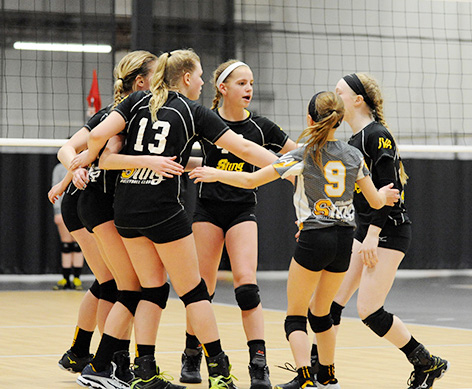Techniques to get your athletes talking
* This is the first of a two-part feature on athlete communication. Part two can be found here.
Frustrated because your athletes are not more vocal during competition and practices?
 Seems like many of them can chat for hours on their cell phones or talk non-stop before, during and after practice about the latest happenings, gossip, movies, videos and other trivial matters off the field, court or track.
Seems like many of them can chat for hours on their cell phones or talk non-stop before, during and after practice about the latest happenings, gossip, movies, videos and other trivial matters off the field, court or track.
So, why then is it so hard to get them to talk to their teammates during practices and competition to share highly relevant and critical performance-related information?
Sadly, many games have been lost simply because of a lack of communication between teammates. Getting athletes, and especially leaders, to be more vocal on the court and field is a challenging and ongoing problem for many coaches. Further, you absolutely need certain athletes at specific positions like point guard, catcher, setter and quarterback to be vocal for your team to be successful.
One of our primary goals with our Leadership Academies is to develop athletes into strong, effective and vocal leaders. As 21-time national champion University of North Carolina women’s soccer coach Anson Dorrance said, “The best type of leadership to me is the student-athlete who is a coach on the field. I want a driving, verbal force who won’t let standards slip. That’s how teams with ordinary talent win championships.”
So, if your lone voice is the only one heard at your practices, you’ve got a problem. As Duke men’s basketball coach Mike Krzyzewski said, “On our Duke basketball teams, I never want to be the only communicator. In order for a message to get across, it must be echoed by every member of the group. I constantly look for the members of my team who can help convey the message.”
We train emerging student-athlete leaders to be vocal in working with the coaches to co-lead the team. We want them leading vocally by setting the tone, reminding people about their responsibilities, reinforcing the positives, refocusing distracted teammates, calling out those who are falling below the team’s standards and being the voice in the locker room when the coach is not around.
Getting athletes to this point is often a process that takes time, training, practice and coaching. Helping an athlete to find his or her voice takes time but pays off in a multitude of ways for you and your program.
Before getting to the strategies, it’s important to examine why athletes are not more vocal on the field or court. In working closely with thousands of student-athlete leaders, we have discovered five primary reasons why they are reluctant to speak up. In an effort to get your athletes to be more vocal, try to determine which of the five reasons listed below might be the greatest inhibitors for your individual players.
Lacking confidence
By far the biggest obstacle that many student-athletes report is that they feel it is not their place to be vocal. Many of them defer to other teammates who they feel have much more legitimacy to lead the team. We often hear things like, “I don’t say much because I don’t want to step on the seniors’ toes.” Or, “I’m not the best guy on the team so I’m not sure if my teammates would even listen to me.” They often defer to those who are older or better than them to be the vocal leaders.
Not understanding the value
Some athletes don’t fully comprehend the value of being vocal on the field or court. They don’t understand how influential they can be as a leader in guiding the team. They wait for the coaches to do most of the talking, putting most of the onus of team leadership on them.
Not in their nature
Some more shy and introverted student-athletes say that being vocal just doesn’t come naturally to them. They are much more comfortable leading by example than being a vocal leader for the team. While this is true, there are still simple things that they can say without transforming themselves into an extrovert. And, if your leaders are passionate, competitive and want to win badly enough, they will find it within themselves to speak up in competition — or else their reluctance to speak will be a contributing factor in losses.
Don’t know what to say
There are some athletes who understand the importance of being vocal and feel they have the legitimacy to speak up, they just aren’t sure of what to say or how to say. These are ones that need some suggestions and coaching on what to say and how to say it.
Not a habit
Finally, being vocal and saying the right things in the right tone of voice is a skill and habit that needs to be cultivated, coached, rewarded and maintained. If having vocal athletes is an important part of your program’s philosophy and team’s success, you must dedicate the time and effort to build it into your program. You must emphasize talking often enough that it becomes an expectation and habit for your athletes.
Without resorting to torture, here are a number of techniques that you can use to get your athletes communicating on a regular basis.
Improving communication
1. The ‘Wastebasketball’ activity. A great way to help your student-athletes understand the importance of being vocal is to set up a short activity where talking is an absolute must. We use an activity I created called “Wastebasketball,” where a blindfolded person tosses wads of paper into a clean wastebasket with the help of their team.
It’s up to the blindfolded person’s teammates to communicate with him or her so that their throws from roughly 10 feet away are as accurate as possible since the person can’t see the target. You can make the activity competitive by creating different groups within your team, timing them for four quarters and keeping score.
After the activity, discuss how challenging it is for the blindfolded person to succeed without the vocal assistance of their teammates. Then relate the activity back to how your team needs to communicate on the court or field to help each other better see what is happening.
2. The smoke jumpers story. In training his leaders to be the driving verbal force he wants them to be, University of North Carolina women’s soccer coach Anson Dorrance uses a real-life story about forest fire smoke jumpers in a great book called “The Leadership Moment,” by Michael Useem. The story tells about the tragic deaths of 12 smoke jumpers who were trying to put out a forest fighter. Because their leader, Wagner Dodge, did not vocally communicate with them about the changing conditions and how they should adjust, 12 fire fighters lost their lives due to their leader’s lack of communication.
While obviously your sport is not a life or death situation, the story vividly and memorably communicates what happens when leaders fail to communicate. Dorrance has his leaders read the “Smoke Jumpers” chapter out of The Leadership Moment and they discuss it as a leadership team. The book also includes several other real-life stories on leadership situations and their consequences.
3. Coach K and Duke’s verbosity. One of the first things you will notice if you attend one of Coach K’s practices at Duke is how vocal his guys are. This is all by design because Coach K values communication so much.
From the start of practice to the end, Duke players are highly vocal in stretching as they count loudly and in unison for each of their stretches. Once practice starts, they are highly vocal in calling out screens and switches on defense. They are also vocal on offense in calling for the ball and outlet passes.
“On the basketball court, there is very little time to get your message across. In the heat of a game, a basketball team speaks a different language; it is not a language based on long sentences, but it is a language nonetheless,” Coach K writes in his book, “Beyond Basketball.” “To acclimate our team to speaking this language, we do not merely drill defensive stances and positioning in our practices — we drill talking. When you talk, your body reacts, your hands get ready and your mind becomes prepared to respond, even under pressure.”
You too can insist upon your players to be vocal in virtually any aspect of practice. Work with your leaders to set the tone and have them help you get and keep everyone else on board.
4. Teach simple vocabulary. To help your athletes become more vocal, it is wise to teach them a common vocabulary that you would like them to use. The specific vocabulary terms are able to quickly and clearly convey messages in the heat of battle. The terms also provide a consistency so that your athletes know exactly what is meant and expected.
Create a glossary of typical terms you want your athletes and staff to use in describing various techniques, drills and strategies. You can go through the terms with your team and include a copy of the glossary in your athletes’ notebooks. Then, of course, have your staff and team practice using the terms during your drills.
5. Provide 360-degree feedback. The biggest jumps we see in athletes becoming more vocal most often occur after receiving 360-degree feedback from their teammates and coaches. 360 feedback is a process that allows teammates and coaches to anonymously provide input on the strengths and areas of improvement for each leader. It’s called 360-degree feedback because the leader receives input from those all around him or her.
The leader gets a comprehensive numerical report on their leadership strengths and areas to improve, as well as helpful comments from their teammates and coaches. Many times leaders will notice a consistent theme that their teammates and coaches are asking — and sometimes begging — them to be more vocal in practices and competitions.
Combined with their leadership scores, these tangible comments provide leaders with the confidence and legitimacy they need to become more vocal leaders for the team.
Click here to continue to part two.





